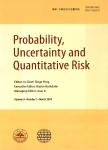A branching particle system approximation for a class of FBSDEs
作者机构:School of MathematicsShandong UniversityJinan 250100People’s Republic of China Department of MathematicsHebei Normal UniversityShijiazhuang 050024People’s Republic of China Department of MathematicsUniversity of MacaoAvenida da UniversidadeTaipaMacaoSpecial Administrative Region of China
出 版 物:《Probability, Uncertainty and Quantitative Risk》 (概率、不确定性与定量风险(英文))
年 卷 期:2016年第1卷第1期
页 面:305-338页
学科分类:07[理学] 0714[理学-统计学(可授理学、经济学学位)] 0701[理学-数学] 070101[理学-基础数学]
基 金:support by National Science Foundation of China NSFC 11501164 Xiong acknowledges research support by Macao Science and Technology Fund FDCT 076/2012/A3 and MultiYear Research Grants of the University of Macao No.MYRG2014-00015-FST and MYRG2014-00034-FST
主 题:Forward-backward stochastic differential equation Partial differential equations Branching particle system Numerical solution
摘 要:In this paper,a new numerical scheme for a class of coupled forwardbackward stochastic differential equations(FBSDEs)is proposed by using branching particle systems in a random ***,by the four step scheme,we introduce a partial differential Eq.(PDE)used to represent the solution of the FBSDE ***,infinite and finite particle systems are constructed to obtain the approximate solution of the *** location and weight of each particle are governed by stochastic differential equations derived from the FBSDE ***,a branching particle system is established to define the approximate solution of the FBSDE *** branching mechanism of each particle depends on the path of the particle itself during its short lifetim ∈=n^(−2α),where n is the number of initial particles and α1/2 is a fixed *** convergence of the scheme and its rate of convergence are obtained.



